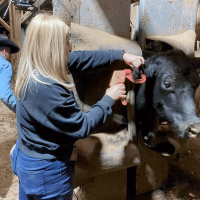
By Jay Jones
Of all the resources the Georgia Department of Agriculture’s Animal Health Office has to respond to an emergency such as an animal disease outbreak, the Animal Disease Traceability Program is a powerful tool that involves cooperation between state animal health officials, veterinarians, and producers.
The current Animal Disease Traceability (ADT) program began in 2013 by the U.S. Department of Agriculture through the Animal and Plant Health Inspection Service. The ADT program establishes minimum identification and documentation requirements to trace livestock moving across state lines. Livestock species covered under ADT are cattle, bison, equine, goats, sheep, poultry, swine, and farmed deer.
Traceability is achieved by applying a form of official ID to an animal. For most livestock species, the official ID is an ear tag. The tags can be visual or electronic. The visual tags are metal or plastic with a unique ID number. Electronic tags can be scanned using a reader, allowing for efficient data management. The official ID is then recorded on a Certificate of Veterinary Inspection (CVI) or other movement document.
Amanda Cathers, GDA Animal Disease Traceability coordinator, explained Georgia adopted the ADT standard set by the USDA, though other states may have more stringent rules. She said the ADT program aims to ensure a rapid response when an animal disease event occurs.
“The basic definition of ADT is that it is a system in place to locate and look at an animal’s movement history during an animal disease investigation,” Cathers said.
She added that ADT doesn’t prevent disease, and the program doesn’t have the capability to track animal movements in real time. She called ADT a tool that state animal health officials can pull from their toolbox to determine where a diseased animal has traveled, identify at-risk animals, and control a disease outbreak.
“The more quickly we can contain a disease will greatly reduce the economic impact that the disease event will have not only on our producers in Georgia but the national livestock industry as a whole,” Cathers said. “That’s the most important message to get across about ADT.”
Since the current traceability program started a decade ago, it has assumed a significant role in agriculture as government officials and industry members contend with animal diseases such as Highly Pathogenic Avian Influenza (HPAI).
In Georgia, agriculture is the state’s largest economic sector, with a strong presence of livestock commodities being raised and transported in and out of state to market, for processing, and livestock shows.
Last year, Jason Duggin, a University of Georgia Beef Extension specialist, estimated roughly 400,000 head of livestock travel through Georgia daily. Duggin spoke at a law enforcement training session about responding to highway accidents involving livestock.
Cathers explained most of the ADT tagging occurs on ranches and farms in cooperation with producers. “You will have a producer, and that’s part of their business operation. They raise livestock and transport across state lines, so they may need their livestock to be tagged,” she said.
Veterinarians play a key role in ADT. Livestock crossing state lines requires a movement document such as a certificate of veterinary inspection (CVI), often referred to as a health certificate. Ear tags can be applied to livestock at the time of an inspection for a CVI or when moving through a livestock market.
The ADT system works with a Premises Identification Number, or PIN, that identifies a physical location where activity affecting the health or traceability of animals may occur. PINs are required for feral hog licenses, livestock shows, and livestock sales. Farms and ranches can also register for a free PIN, according to the GDA Animal Health website.
The tags used for ADT have the animal’s unique identification number, which is recorded in a database. Together, the PINs, animal IDs, and movement documents like CVIs are used by Animal Health officials to quickly identify the location and movements of diseased animals to reduce the threat of a disease outbreak.
Cathers said if needed, a disease investigation starts with the animal’s official ID ear tag, which can be traced through the state database and matched to locations recorded.
“We can then trace its history. Where did the animal come from? What other animals may have comingled with it?”
Cathers was named the Animal Disease Traceability coordinator for Georgia in 2019 to enhance the program for the benefit of Georgia livestock producers. The statewide ADT database was established in 2020, and GDA has scored well in USDA’s annual performance testing, administered to states and tribal lands to assess readiness to conduct animal disease tracing if needed.
“USDA ADT program staff will send me an official ID ear tag number and from there ask a question like ‘Where did this animal originate?’ and ‘What state is the animal from?’ Cathers said. “We’ve been very successful in completing these performance tests. Usually, we can trace an animal within 15 minutes.”
For more information about Animal Disease Traceability in Georgia, visit the GDA Animal Health and Diseases webpage at https://agr.georgia.gov/animal-health-diseases. To learn more about the USDA’s animal disease prevention and outbreak response efforts, visit the APHIS Animal Traceability webpage at https://bit.ly/3TLuCrM.
Authored by Jay Jones, this article appeared in the January 10, 2024 edition of the Georgia Market Bulletin and Consumers Market Bulletin.


